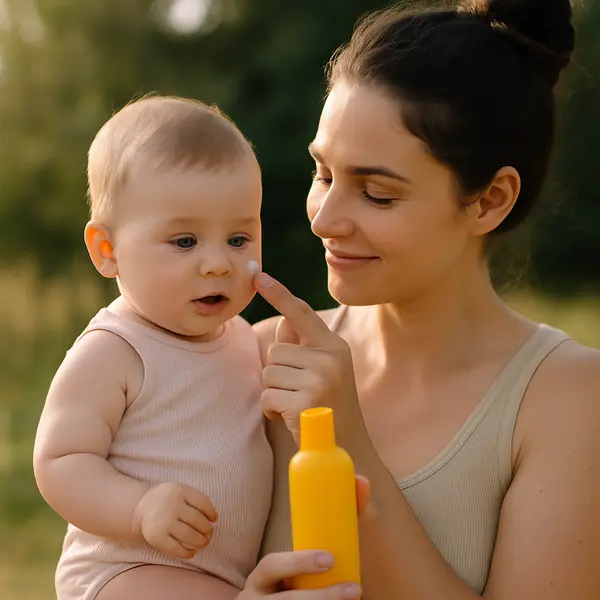- Best Sunscreen for Babies: Your Ultimate Guide to Safe Sun Protection
- Why Is Choosing the Best Sunscreen for Babies So Important?
- What Makes a Sunscreen Safe for Babies?
- Best Sunscreen for Babies: Top Dermatologist-Recommended Brands
- Complete Sun Safety: More Than Just Sunscreen
- When Can Babies Start Using Sunscreen?
- Final Thoughts: Making a Safe Choice for Your Baby
Best Sunscreen for Babies: Your Ultimate Guide to Safe Sun Protection
Keeping your baby safe in the sun is one of the most important steps you can take as a parent. Choosing the best sunscreen for babies is essential, especially since their delicate skin is more vulnerable to ultraviolet damage. Fortunately, this guide will help you find sunscreens that are not only safe and gentle but also meet expert recommendations and offer superior protection.
Why Is Choosing the Best Sunscreen for Babies So Important?
Babies have thin, sensitive skin that can burn quickly. Moreover, UV exposure in infancy contributes significantly to cumulative lifetime damage. Just one blistering sunburn in childhood can double the risk of developing melanoma later in life. Therefore, choosing the best sunscreen for babies is not just about comfort—it’s about long-term health and safety.
What Makes a Sunscreen Safe for Babies?
The best sunscreen for babies should meet the following criteria:
- Mineral-based: Choose sunscreens that contain zinc oxide or titanium dioxide. These ingredients are FDA-recognized as safe and effective for infants.
- Broad-spectrum protection: This ensures coverage against both UVA and UVB rays.
- SPF 30 or higher: Provides protection from at least 97% of harmful UV rays.
- Fragrance-free: Reduces risk of allergic reactions.
- Water-resistant: Ideal for active outdoor play; look for up to 80 minutes of resistance.
As a result, selecting a sunscreen with all these characteristics can make a significant difference in your baby’s sun safety.
Best Sunscreen for Babies: Top Dermatologist-Recommended Brands
After reviewing dozens of options and gathering expert input, here are some top picks parents can trust:
La Roche-Posay Anthelios Mineral Sunscreen SPF 50
- Active ingredients: Titanium dioxide 5%, Zinc oxide 15%
- Pros: Lightweight, non-greasy, unscented, water-resistant
- Why it’s great: Easy to apply and ideal for sensitive skin.
Babo Botanicals Sensitive Baby SPF 50
- Active ingredients: Non-nano zinc oxide
- Pros: EWG-verified, botanical ingredients, sheer finish
- Why it’s great: Perfect for sensitive and allergy-prone skin.
Blue Lizard Baby Mineral Sunscreen SPF 50+
- Active ingredients: Zinc oxide 10%, Titanium dioxide 8%
- Pros: Affordable, blends well, fragrance-free
- Why it’s great: A gentle and reliable option for daily use.
Hello Bello SPF 50 Stick
- Pros: Compact, mess-free, easy to apply
- Why it’s great: Convenient for on-the-go sun protection.
Badger Baby Mineral Sunscreen Cream
- Pros: Organic, eco-friendly, water-resistant
- Why it’s great: Ideal for eco-conscious families.
In short, any of these top picks can provide effective sun protection while being gentle enough for daily use.
Ingredients to Avoid in Baby Sunscreens
Certain chemical ingredients found in adult sunscreens are not recommended for babies:
- Oxybenzone: May disrupt hormones.
- Octinoxate: Potential skin allergen.
- Fragrances and alcohol: Can irritate and dry out the skin.
Therefore, it’s best to stick with gentle, mineral-only sunscreens free of these additives.
Complete Sun Safety: More Than Just Sunscreen
Use Protective Clothing
To begin with, dress babies in long-sleeved, lightweight clothing with UPF ratings. Dense fabrics like denim or layered cotton can offer UPF ratings of 500 or more.
Stay in the Shade
Additionally, use canopies, umbrellas, or pop-up tents—especially between 10 a.m. and 4 p.m. when the sun’s rays are strongest.
Don’t Forget Accessories
Furthermore, add a wide-brimmed hat and baby sunglasses to your sun protection toolkit.
How to Apply Baby Sunscreen Properly
- Apply 15 minutes before sun exposure.
- Use a generous amount and cover all exposed skin evenly.
- Reapply every 2 hours, or more often if swimming or sweating.
- Don’t forget ears, neck, feet, and the back of the hands.
When applied correctly and consistently, sunscreen can significantly reduce the risk of sun damage.
When Can Babies Start Using Sunscreen?
The American Academy of Pediatrics advises that babies under 6 months should avoid sunscreen as their skin is still developing. Instead, rely on clothing and shade. However, in unavoidable situations, a small amount of mineral sunscreen can be used on limited areas like the face or hands.
Final Thoughts: Making a Safe Choice for Your Baby
Choosing the best sunscreen for babies goes beyond SPF labels. Ultimately, it’s about prioritizing safe ingredients, ease of use, and broad-spectrum protection. With dermatologist-approved products and smart sun habits, you can keep your baby’s skin healthy for life.
So whether it’s a beach day or a stroll through the park, the right sunscreen ensures that sunny days stay safe and enjoyable.
The following post may interest you
Why Does My Baby Scratch Their Face?
Sources
Sunscreen Label Marketing Towards Pediatric Populations: Guidance for Navigating Sunscreen Choice
Sun-safe practices in different pediatric patients
https://www.contemporarypediatrics.com/view/sun-safe-practices-in-different-pediatric-patients
Interest of external photoprotection by means of clothing and sunscreen products in young children

